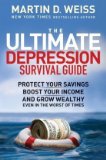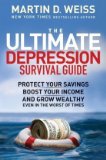The Ultimate Depression Survival Guide by Martin D. Weiss
Today, I’m reviewing a book, titled The Ultimate Depression Survival Guide written by Martin D. Weiss.
With the present downturn in the economy, it has never been more vital than now to have a sound and effective financial and personal plan for the future. You need to know how to safeguard your money, and grow it even in the face of the present credit crunch, housing bust, and fall of the US dollar.
In this book: The Ultimate Depression Survival Guide, Dr. Martin Weiss provides the strategies and guidance to help you avoid losing your hard-earned money in stocks, real estate, currency trading, and other investment windows, but instead be on top of the investment game.
Written in simple, easy to follow format that almost everyone can read, understand and implement, the book explains how the current economy depression came about, how to profit in it, what the next phase will be like, and how to take position now to solidify your wealth tomorrow.
And it didn’t forget to expose and dissect the hidden profit making potential in such investment windows as global investing, foreign currencies, and commodities for tomorrow’s smart investors.
It’s a book you must read to tap into the brain of one of America’s most gifted Consumer Advocate for Financial Safety, who actually precisely warned of the present financial crises long before it happened, as attested to by the New York Times, which described him as, “The first to warn of the dangers and say so unambiguously”.
By his accurate forecasting, Dr. Martin Weiss also helped thousands of investors from losing their money in Fannie Mae, Wachovia Bank, Washington Mutual, General Motors, Citigroup, Lehman Brothers, and the other major firms in distress, when he predicted their financial difficulties long ago.
I read this book recently, and it was wow! Here, I want to share with you an excerpt from the book, where Dr. Martin Weiss revealed how one can actually make money in the present economy meltdown:
How To Profit Directly From The Decline
Most people don’t think about profiting directly from a market decline. They don’t understand the concept, and they don’t know how. That’s a shame, because one of the key things you need to help get you through tough times is money. And in bad times, sometimes the best defense is to go on the offense.
Others don’t consider this opportunity because they think there’s something sinister about making good money in bad times. The fact is that the more people who can build wealth, the better it will be for everyone.
From an early age, we are taught that “up†is good and “down†is bad. So most people don’t like declines. But that kind of bias has no place in investing strategies. Especially in a depression, serious investors must learn how to invest in both up and down markets.
Bernard Baruch’s axiom to never follow the crowd is especially critical. It you follow the crowd, you could end up buying stocks when investors are the most enthusiastic (at the market’s top) and selling when they are the most downtrodden (at the bottom). Don’t fall into that trap. Even if Wall Street experts or your own friends deride your approach, do not let that stop you from making rational, prudent decisions.
You don’t have to be an expert to make money in the market. In fact, sometimes, those who are new to the world of investing can see the big picture more clearly than veterans who have been cocooned on Wall Street.
Whenever the government makes a new announcement to bail out this or that company or to prop up this or that credit market or to announce a new economic stimulus package, you can typically expect bursts of optimism on Wall Street. But that’s probably the worst time to buy and the best time to sell. If you see that kind of a rally in the market, use it as your window to get out, or to buy contrarian investments like inverse ETFs.
Large Profit Potential With Inverse ETFs
With inverse ETFs, the potential for profit is quite extraordinary, even if the market is not moving dramatically. For example, between June 5 and July 15, 2008, as tech stocks fell, the inverse ETF that’s tied to technology stocks enjoyed a gain of 30.9 percent, while the inverse ETF tied to the semiconductor index rose 37.2 percent. Those are large gains for such a short period of time.
As the markets became more volatile in September and October 2008, the potential gains in inverse ETFs were even larger. We saw a 61 percent gain in just 15 days as the technology sector fell between September 25 and October 10; an 89.1 percent gain in just 19days as the real estate sector dropped between September 26 and October 15; an 89.6 percent gain in 19 days as the consumer services sector plunged between September 26 and October 15; and an 89.9 percent gain in 8 days as the financial sector slumped between October 1 and October 9.
Unfortunately, we can’t go back in time to grab those profits. Nor is it possible to catch the tops and bottoms of each major move. But it’s crucial to understand two things: First, unlike short-selling on margin, which exposed Dad to much higher risk, in each case I just cited, your risk is inverse ETFs is strictly limited to what you invest- not a penny more. And second, these kinds of gains can go a long way toward helping you through an economic crisis.
Just bear in mind that the market does not go down in a straight line; there are always going to be rallies, and sometimes they could be quite sudden. When that happens, the inverse ETFs fall in value. Like any other investment, the goal is to buy them low and sell them high. If you wind up doing the opposite, you will suffer losses.
If you cannot afford any losses, this strategy is not for you. But if you have risk capital and you can set aside a modest portion for an aggressive strategy in falling markets, follow the steps below.
How To Go For Profits In A Down Market
Step 1. Make sure you understand the ins and outs of inverse ETFs.
Step 2. Recognize that you can lose money in inverse ETFs. So for this strategy, allocate strictly the funds you can afford to risk.
Step 3. Apply essentially the same tried-and-tested discipline for investing in a bull market, but in reverse:
In a bull market, astute traders seek to buy on dips and sell on rallies. When using inverse ETFs in a bear market, do the opposite: Buy the inverse ETFs on a stock market bounce; sell them after major stock market declines.
In a bull market, astute traders wait for temporary bouts of bad news to help drive prices down and give them a bargain-buying opportunity. They know that, as long as there are solid signs that the economy will continue growing, the stock market can climb a wall of worry.
When using inverse ETFs in a down market, do precisely the opposite: Wait for good newsto help drive prices up. Then, buy the inverse ETFs in anticipation of another decline. As long as it’s clear that the economy will continue to contract, the stock market is likely to slide down a slippery slope of hope.
Step 4. Recognize that fundamental indicators that make sense in an up market may not be appropriate for a down market. For example,
In normal times, the cheaper the stock in relation to its earnings, the more attractive it is. But in a depression, many companies have no earnings, rendering useless any measures of value based on earnings.
Normally, the company’s book value (assets minus liabilities) is another good measure. In a depression, however, as asset values fall and large debts are still outstanding, the book value is less than zero.
Step 5. Diversify among several stock market sectors while also using inverse ETFs that represent the most diverse basket of stocks. Examples of the most diversified ETFs include those with the symbols DOG or DXD, which move inversely to the Dow Jones Industrial Average; and SH, SDS, or RSW, which move inversely to the S&P 500 Index.
The Ultimate Depression Survival Guide by Martin D. Weiss is a book I very much recommend for all investors, and anyone who is interested in growing their money through investing – you need to know exactly what you are doing to avoid burning your fingers.

Hi
Thanks this is a greate site and article! I found your link from a comment you left on Problogger. I am reading up as much as I can about money and how investment works. I wrote an article about my wake-up call on my blog called ‘Is frugal a four letter word?’ No, it’s not a success story, it’s a wake-up call story!
I am adding your site to my favorites to inspire me.
I am wondering about the title of the book though, when I saw it I thought it was about the clinical condition – being depressed.